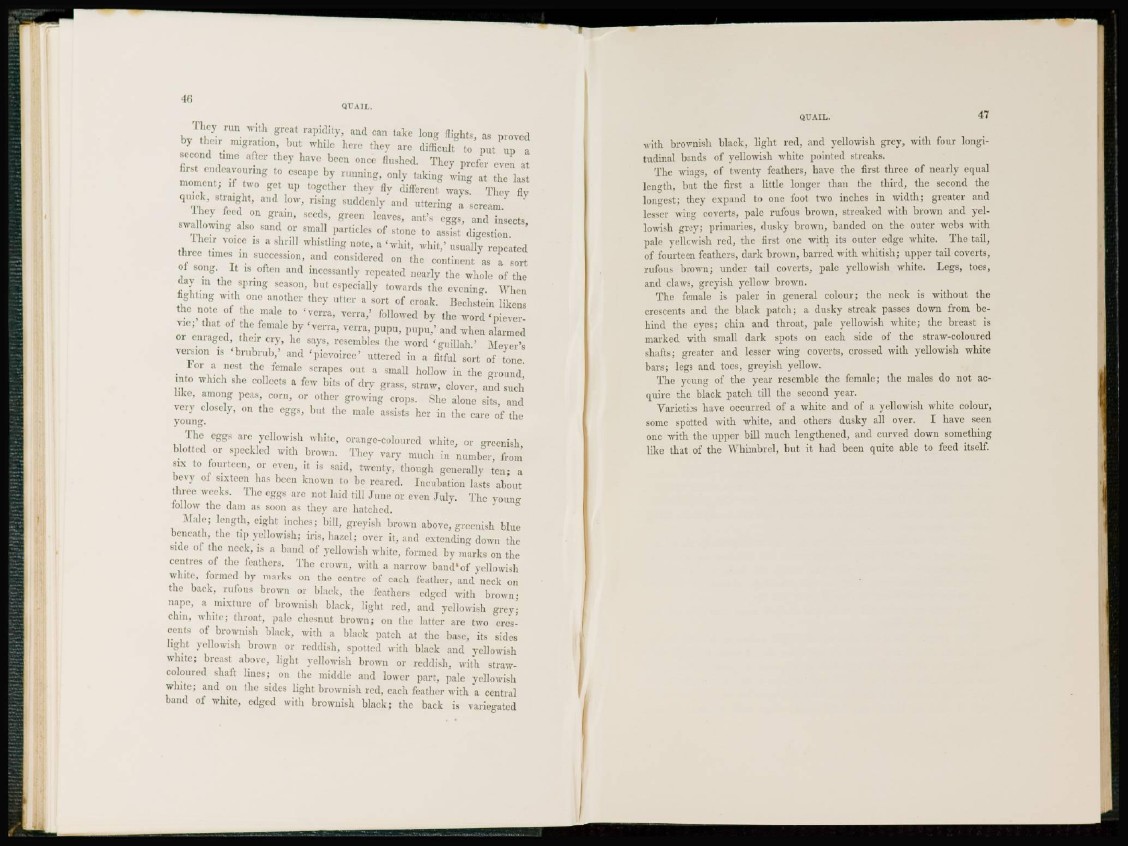
(fi
QUAIL.
They run with great rapidity, and can take long flights, as proved
by their migration, but while here they are difficult to put up a
second time after they have been once flushed. They prefer even at
first endeavouring to escape by running, only taking wing at the last
moment; if two get up together they fly different ways. They fly
quick, straight, and low, rising suddenly and uttering a scream.
They feed on grain, seeds, green leaves, ant's eggs, and insects,
swallowing also sand or small particles of stone to assist digestion.
Their voice is a shrill whistling note, a ' whit, w h i t , ' u s u a l l y repeated
three times in succession, and considered on the continent as a sort
of song. It is often and incessantly repeated nearly the whole of the
day in the spring season, bul especially towards the evening. When
fighting with one another they utter a sort of croak. Bechstein likens
the note of the male to 'vcrra, vcrra,' followed by the w o r d ' p i e v e r -
v i e ; ' that of the female by ' v c r r a , vcrra, pupu, p u p u , ' and when alarmed
or enraged, their cry, he says, resembles the word ' g u i l l a h . ' Meyer's
version is ' b r u b r u b , ' and ' p i e v o i r c e ' uttered in a fitful sort of tone.
For a nest the female scrapes out a small hollow in the ground,
into which she collects a few bits of dry grass, straw, clover, and such
like, among peas, corn, or other growing crops. She alone sits, and
very closely, on the eggs, hut the male assists her in the care of the
young.
The eggs are yellowish white, orange-coloured white, or greenish,
blotted or speckled with brown. They vary much in number, from
six to fourteen, or even, it is said, twenty, though generally ten; a
bevy of sixteen has been known to he reared. Incubation lasts about
t h r e e weeks. The eggs are not laid till J u n e or even J u l y . The young
follow the dam as soon as they are hatched.
Male; length, eight inches; bill, greyish brown above, greenish blue
beneath, the tip yellowish; iris, hazel; over it. and extending down the
side of the neck, is a band of yellowish white, formed by marks on the
centres of the feathers. The crown, with a narrow band*of yellowish
white, formed by marks on the centre of each feather, and neck on
the back, rufous brown or black, the leathers edged with brown;
nape, a mixture of brownish black, light red, and yellowish grey;
chin, white; throat, pale chesnut brown; on the latter are two crescents
of brownish black, with a black patch at the base, its sides
light yellowish brown or reddish, spotted with black and yellowish
white; breast above, light yellowish brown or reddish, with strawcoloured
shaft lines; on the middle and lower part, pale yellowish
w h i t e ; and on the sides light brownish red, each feather with a central
band of white, edged with brownish black; the back is variegated
with brownish black, light red, and yellowish grey, with four longitudinal
bands of yellowish white pointed streaks.
The wings, of twenty feathers, have the first three of nearly equal
length, hut the first a little longer than the third, the second the
longest; they expand to one foot two inches in width; greater and
lesser wing coverts, pale rufous brown, streaked with brown and yellowish
grey; primaries, dusky brown, banded on the outer webs with
pale yellowish red, the first one with its outer edge white. The tail,
of fourteen feathers, dark brown, barred with whitish; upper tail coverts,
rufous brown; under tail coverts, pale yellowish white. Legs, toes,
and claws, greyish yellow brown.
The female is paler in general colour; the neck is without the
crescents and the black patch; a dusky streak passes down from behind
the eyes; chin and throat, pale yellowish white; the breast is
marked with small dark spots on each side of the straw-coloured
shafts; greater and lesser wing coverts, crossed with yellowish white
bars; legs and toes, greyish yellow.
The young of the year resemble the female; the males do not acquire
the black patch till the second year.
Varieties have occurred of a white and of a yellowish white colour,
some spotted with white, and others dusky all over. I have seen
one with the upper bill much lengthened, and curved down something
like that of the Whimbrel, but it had been quite able to feed itself.